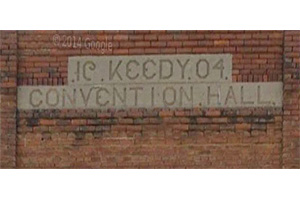
 |
 |
||||||||||||||||||||||||||||||||||||||||||||||
Well, that's enough, some would say. Now it has 30,000 souls. Not sure why I went there, but I never remember the original spur. Probably haven’t looked at these images in almost a year. Let’s see what I selected . . . Hmm. Well. I wonder if the very topography violates the ADA.
Again, you can do a lot with brick, if you haven’t a budget, and it’s one way to show the townsfolk you’re careful with money.
“Cold Drinks and a Lil Monkey Business.” Not Donkey Business?
There's very small marker on the second floor to commemorate the building’s owners. (I think it says Bros.) Let’s zoom in . . . yes.
If only I had a platt map to see what was there once upon a time. Oh hey, I do:
It's amazing what you can find on the internet.
Here’s a corner you could find in any town. OUMB, but not that U.
Gee, should we emphasize the service core? Why not
How about some sweeping vistas, with a broad expanse of glass to provide intriguing illumination at night? Nah
I suppose it would be okay if they used it as a drive-in theater, but I don't think that's the case.
I like this. Tidy mid-century modern.
But I suspect the bottom floor was redone in the 80s.
New sidewalks, planters - wonder if it helped.
Everything about that glass-bricked series of windows intrigues me. Why the narrow ones, what the originals looked like, what the building’s original function might have been.
What did the originals look like? Were they always bricked up? What was the door like, and where did it go? Yes, yes, I know, inside. Unless you were already there.
“We figure a combination hard-drinker’s bar / swinger’s club / planetarium ought to do some good business here”
The countryside abounds with these. Hopeful and abstract.
They still say "church" in their own way, but only because nothing else really looks like this.
"Downtown needs something that both tourists and locals will appreciate: the calm, appraising stare of a dead-souled man who may shoot you for your property, wife, or both."
|
|||||||||||||||||||||||||||||||||||||||||||||||
 |
 Sometimes a place just might be cursed from the get-go: "Before its founding, Gillette started as Donkey Town named after Donkey Creek and then was moved and called Rocky Pile after Rocky Draw." Then they named it after a railroad worker. "In November 1895, a fire destroyed most of Gillette. Only two saloons, two stores, and a restaurant survived."
Sometimes a place just might be cursed from the get-go: "Before its founding, Gillette started as Donkey Town named after Donkey Creek and then was moved and called Rocky Pile after Rocky Draw." Then they named it after a railroad worker. "In November 1895, a fire destroyed most of Gillette. Only two saloons, two stores, and a restaurant survived." 































